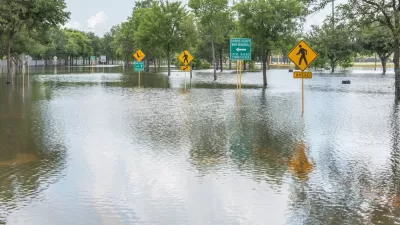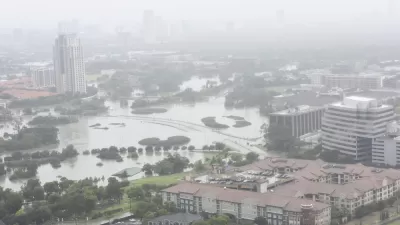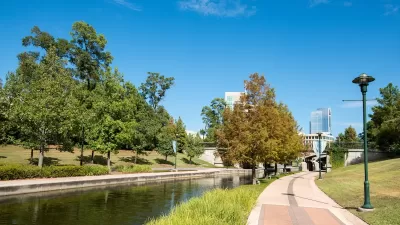History shows that there's more than one way to control flooding, but the best ideas are also urban amenities.

After Hurricane Harvey's destruction, but before money for rebuilding pours in, Jose Solis takes a page in the Houston Chronicle to consider how two cities responded to major floods in the fairly distant past.
"The histories of San Antonio and Los Angeles," Solis writes, "provide strong arguments for why design should play an essential role in developing new infrastructure and a cautionary tale for what happens when it is ignored."
Both Los Angeles and San Antonio experienced major flooding in the 1920s and '30s that brought a great deal of federal funding for major infrastructure to prevent future losses. Los Angeles, using a strategy typical of both the urbanism of the era and of the city itself, buried the Los Angeles River, replacing it with an effective but joyless concrete channel; San Antonio built Riverwalk, which works as a flood control device but also as an amenity for residents and a huge tourist draw.
History has been much kinder to Riverwalk, and Los Angeles is preparing to spend a great deal of money to remake the LA River into something more like it. (Houston's neighbor, New Orleans, also embraced the idea of amenity-as-flood-control after its own catastrophes.)
Solis praises New York City's post-Sandy Rebuild by Design competition as something that "evolved into a broader initiative for rebuilding cities to be more resilient" and suggests that Houston initiate something similar.
"Rebuild by Design," Solis continues, "provides a blueprint for how Houston can attract leading thinkers to develop solutions that will not only protect us during future floods, but let people enjoy living here for all the times between."
FULL STORY: As Houston rebuilds, we need amenities, not eyesores

Alabama: Trump Terminates Settlements for Black Communities Harmed By Raw Sewage
Trump deemed the landmark civil rights agreement “illegal DEI and environmental justice policy.”

Planetizen Federal Action Tracker
A weekly monitor of how Trump’s orders and actions are impacting planners and planning in America.

Why Should We Subsidize Public Transportation?
Many public transit agencies face financial stress due to rising costs, declining fare revenue, and declining subsidies. Transit advocates must provide a strong business case for increasing public transit funding.

Understanding Road Diets
An explainer from Momentum highlights the advantages of reducing vehicle lanes in favor of more bike, transit, and pedestrian infrastructure.

New California Law Regulates Warehouse Pollution
A new law tightens building and emissions regulations for large distribution warehouses to mitigate air pollution and traffic in surrounding communities.

Phoenix Announces Opening Date for Light Rail Extension
The South Central extension will connect South Phoenix to downtown and other major hubs starting on June 7.
Urban Design for Planners 1: Software Tools
This six-course series explores essential urban design concepts using open source software and equips planners with the tools they need to participate fully in the urban design process.
Planning for Universal Design
Learn the tools for implementing Universal Design in planning regulations.
Caltrans
Smith Gee Studio
Institute for Housing and Urban Development Studies (IHS)
City of Grandview
Harvard GSD Executive Education
Toledo-Lucas County Plan Commissions
Salt Lake City
NYU Wagner Graduate School of Public Service





























